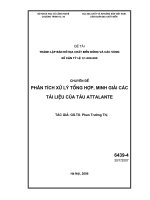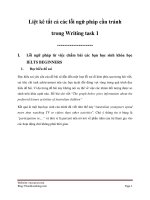Tổng hợp bài mẫu các dạng bài của IELTS writing task 1 (8 dạng bài thường gặp)
Bạn đang xem bản rút gọn của tài liệu. Xem và tải ngay bản đầy đủ của tài liệu tại đây (676.1 KB, 12 trang )
Tong hợp bài màu càc dàng bài cuà
IELTS Writing Tàsk 1 (Bànd 9)
1. IELTS DIAGRAM
Model answer (band 9)
The diagram illustrates how an Australian town collects rainwater to process in order
to use as drinking water. Overall, rainwater collected from houses can be used for
drinking after it has been processed by being filtered and then being treated with
chemicals.
Initially, the rain which falls on the rooftop is collected by the guer and then runs
down the pipe at the side of the house into the drain at the boom. Each house collects
rainwater in this way and the rainwater is then passed along underground drains to the
water filter.
1
The rainwater passes through the water filter to remove any impurities. Once it has
been filtered, it continues along the pipes to a storage tank. From this point, the water
goes from storage to the water treatment. At this stage of the process, the water is treated
with chemicals in order to make it fit for consumption. When the water is ready for
drinking, it travels along pipes that lead back into the houses in the town where people
can use the water for daily consumption.
(179 words)
Model Answer
2
The diagrams illustrate the way in which cement is made and how it is then
used in the process of making concrete.
Overall, limestone and clay pass through four stages before being bagged
ready for use as cement which then accounts for 15% of the four materials used to
produce concrete. While the process of making cement uses a number of tools, the
production of concrete requires only a concrete mixer.
In the first stage of making cement, limestone and clay are crushed together
to form a powder. This powder is then combined in a mixer before passing into a
rotating heater which has constant heat applied at one end of the tube. The
resulting mixture is ground in order to produce cement. The final product is
afterwards put into bags ready to be used.
Regarding the second diagram, concrete consists of mainly gravel, which is
small stones, and this makes up 50% of the ingredients. The other materials used
are sand (25%), cement (15%) and water (10%). These are all poured into a
concrete mixer which continually rotates to combine the materials and ultimately
produces concrete.
3
2. THE BAR CHART AND PIE CHART MODEL ANSWER
Model answer
The bar chart and pie charts illustrate the percentage of people in Glasgow having
three levels of education (university, school and those with no qualifications) in 2010.
4
Information is divided into five age groups in the bar chart and by gender in the pie
charts.
Overall, the majority of people with university education were in younger age groups,
while in the oldest age group most people did not have any qualifications. The
proportions of men and women were similar and showed lile different between the levels
of education.
The percentage of people with university education was up to 76% in the younger
three age groups compared to only 50% in those ages 50 to 75 and just 25% in those over
75. This trend was reversed in those with no qualifications (9% in younger people rising
to 72% in the oldest age group). The figure for those with school education was relatively
constant at around 20% but was as low as 3% in the over 75’s.
The proportion of men and women in each level of education was around one third
with only a slightly difference of 3% in university graduates as well as those who didn’t
have educational qualifications.
Words = 198
3. TABLE
Model answer
5
The table illustrates the proportion of national expenditure in Ireland, Italy, Spain,
Sweden and Turkey on three categories of items in 2002.
Overall, all countries spent most on food, drinks and tobacco, which was almost three
times that of the other items. The lowest expenditure was on leisure and education in the
five countries. The expenditure of Turkey overall was higher than the other countries.
In terms of food, drinks and tobacco, Turkey spent the most at 32.14%. The
expenditure of Ireland was also high (28.91%) compared to Sweden which spent the least
(15.77%). Spain and Italy spent 18.80% and 16.36% respectively.
Italy spent more than the other countries on clothing and footwear (9%) as opposed to
the lowest expenditure which could be seen in Sweden at 5.40%. The other three
countries spent on average around 6.5%.
The lowest expenditure was on leisure and education which accounted for under 5%
in all countries. Turkey spent most on these items at just 4.35% of their national
expenditure which is around double that of Spain which spent the least at just 1.98%.
6
4. MAP
Model answer
The maps illustrate how Meadowside village and Fonton, which is a neighbouring town,
have developed over three different time periods (1962, 1985 and the present).
Overall, Meadowside village increased in size and has become Meadowside Suburb as it
merged together with Fonton. Furthermore, there have been significant changes in In
1962, both Meadowside and Fonton were completely separate with no roads or rail
7
connecting them. While Fonton had a railway line running through it to the north,
Meadowside, located to the west of Fonton, only had a small road from the west.
By 1985, there was a considerable growth in the size of Meadowside village and Fonton.
The small road in Meadowside village had been converted into a main road and was also
extended to the east to connect with Fonton. Meadowside, moreover, had also developed
a housing estate in the west, a leisure complex and a supermarket in the south.
Currently, both Meadowside, which is now a suburb, and Fonton are joined. The railway
line, which runs through Fonton, has been extended to the west where a train station has
been built. To the north of the station, a hotel has been constructed and opposite the
station, to the south, there is now a business park.
5. LINE GRAPH AND BAR CHART
8
Model answer
The line graph illustrates the number of UK residents going abroad from the UK and
overseas residents visiting the UK between 1979 and 1999, while the bar chart gives
information about how many UK residents travelled to five of the most popular countries
in 1999. Units are measured in millions of people.
Overall, there was an increase in the number of visits to and from the UK and there were
more visits abroad by UK residents than visits to the UK by overseas residents over the
period given. Furthermore, the most popular country to visit by UK residents was France
in 1999.
The number of UK residents visiting overseas began at just under 15 million in 1979 and
rose significantly to reach over 50 million in 1999. Around 10 million overseas residents
visited the UK in the first year before climbing steadily to just under 30 million by the
final year.
In 1999, France was visited by over 10 million UK residents, followed by Spain at
approximately 9 million. The USA and Greece had about 4 million and 3 million visitors
respectively. The least popular country visited was Turkey which had only about 2
million UK residents going there.
6. PIE CHART
Sample Answer
The two pie charts illustrate the proportion of five types of energy production in
France in 1995 and 2005.
Overall, in both years, the most significant sources of energy were gas and coal,
which together accounted for over half the production of energy, while nuclear and
other kinds of energy sources generated the least amount of energy in France. In
9
all types of energy production there was only minimal change over the 10 year
period.
Energy produced by coal comprised of 29.80% in the first year and this showed
only a very slight increase of about a mere 1 % to 30.9% in 2005. Likewise, in
1995, gas generated 29.63% which rose marginally to 30.1% 10 years later.
With regards to the remaining methods of producing energy, there was an
approximate 5% growth in production from both nuclear power and other sources
to 10.10% and 9.10% respectively. Petrol, on the other hand, was the only source
of energy which decreased in production from 29.27% in 1995 to around a fifth
(19.55%) in 2005.
7. LINE GRAPH
Sample Answer
The line graph illustrates the amount of three kinds of spreads (margarine, low fat and
reduced spreads and buer) which were consumed over 26 years from 1981 to 2007. Units
are measured in grams.
Overall, the consumption of margarine and buer decreased over the period given,
while for low fat and reduced spreads, it rose. At the start of the period, buer was the
most popular spread, which was replaced by margarine from 1991 to 2001, and following
that low fat and reduced spreads became the most widely used spread in the final years.
10
With regards to the amount of buer used, it began at around 140 grams and then
peaked at 160 grams in 1986 before falling dramatically to about 50 grams in the last
year. Likewise, approximately 90 grams of margarine was eaten in the first year after
which the figure fluctuated slightly and dropped to a low of 40 grams in 2007.
On the other hand, the consumption of low fats and reduced spreads only started in
1996 at about 10 grams. This figure, which reached a high of just over 80 grams 5 years
later, fell slightly in the final years to approximately 70 grams in 2007.
8. BAR CHART
Sample answer
The chart illustrates the amount of money spent on five consumer goods (cars,
computers, books, perfume and cameras) in France and the UK in 2010. Units are
measured in pounds sterling.
Overall, the UK spent more money on consumer goods than France in the period
given. Both the British and the French spent most of their money on cars whereas
the least amount of money was spent on perfume in the UK compared to cameras
in France. Furthermore, the most significant difference in expenditure between the
two countries was on cameras.
11
In terms of cars, people in the UK spent about £450,000 on this as opposed to the
French at £400,000. Similarly, the British expenditure was higher on books than
the French (around £400,000 and £300,000 respectively). In the UK, expenditure
on cameras (just over £350,000) was over double that of France, which was only
£150,000.
On the other hand, the amount of money paid out on the remaining goods was
higher in France. Above £350,000 was spent by the French on computers which
was slightly more than the British who spent exactly £350,000. Neither of the
countries spent much on perfume which accounted for £200,000 of expenditure in
France but under £150,000 in the UK.
------Chúc các bạn may mắn-----
12









